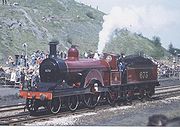
Midland Railway 115 Class
Encyclopedia

Midland Railway
The Midland Railway was a railway company in the United Kingdom from 1844 to 1922, when it became part of the London, Midland and Scottish Railway....
115 Class is a class of 4-2-2
4-2-2
Under the Whyte notation for the classification of steam locomotives, 4-2-2 represents the wheel arrangement of four leading wheels on two axles, two powered driving wheels on one axle, and two trailing wheels on one axle....
steam locomotive
Steam locomotive
A steam locomotive is a railway locomotive that produces its power through a steam engine. These locomotives are fueled by burning some combustible material, usually coal, wood or oil, to produce steam in a boiler, which drives the steam engine...
. They were known as "Spinners", possibly because of the wheelslip
Wheelslip
Articles on Wheelslip include:* Locomotive wheelslip, railways* Wheelspin, road vehicles* Wheelspin...
that the single large driving wheel
Driving wheel
On a steam locomotive, a driving wheel is a powered wheel which is driven by the locomotive's pistons...
caused. They were designed by Samuel W. Johnson
Samuel W. Johnson
Samuel Waite Johnson was Chief Mechanical Engineer of the Midland Railway from 1873 to 1903. He was born in Bramley, Yorkshire and educated at Leeds Grammar School.-Career:...
and a total of 15 of the class were built between 1896-1899.
It was quite common for this class of engine to pull a typical Midland express weighing 200 and 250 tons which suited the Class 115 perfectly. Given a dry rail they could maintain a tight schedule with 350 tons. Speeds up to 90mph were not uncommon and the sight of their whirring huge driving wheels earned them the nickname "Spinners".
Thanks to the Midland's practice of building low powered locomotives and relying on double heading to cope with heavier trains many enjoyed working lives of up to 40 years. They made ideal pilot engines for the later Johnson/Deeley 4-4-0 classes.
In the Midland Railway 1907 renumbering scheme, they were assigned numbers 670–684. During the World War one most were placed in store but surprisingly pressed into service afterwards as pilots on the Nottingham to London coal trains. Twelve locomotives survived to the 1923 grouping, keeping their Midland Railway numbers in London, Midland and Scottish Railway
London, Midland and Scottish Railway
The London Midland and Scottish Railway was a British railway company. It was formed on 1 January 1923 under the Railways Act of 1921, which required the grouping of over 120 separate railway companies into just four...
service. Nevertheless by 1927 only three of the class remained, with the last engine, 673 (né 118) being withdrawn in 1928 and preserved.
Preservation
No. 673 is the sole survivor of its class. It was steamed around 1976–1980 when it took part in the Rainhill TrialsRainhill Trials
The Rainhill Trials were an important competition in the early days of steam locomotive railways, run in October 1829 in Rainhill, Lancashire for the nearly completed Liverpool and Manchester Railway....
150th cavalcade but is currently a static exhibit in the National Railway Museum
National Railway Museum
The National Railway Museum is a museum in York forming part of the British National Museum of Science and Industry and telling the story of rail transport in Britain and its impact on society. It has won many awards, including the European Museum of the Year Award in 2001...
in York
York
York is a walled city, situated at the confluence of the Rivers Ouse and Foss in North Yorkshire, England. The city has a rich heritage and has provided the backdrop to major political events throughout much of its two millennia of existence...
.

